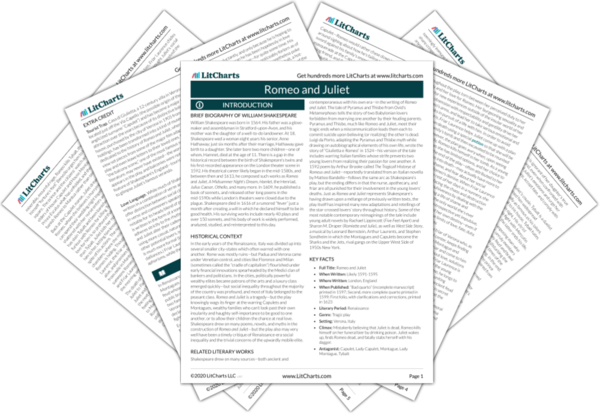Welcome to the LitCharts study guide on William Shakespeare's Romeo and Juliet. Created by the original team behind SparkNotes, LitCharts are the world's best literature guides.
Romeo and Juliet: Introduction
Romeo and Juliet: Plot Summary
Romeo and Juliet: Detailed Summary & Analysis
Romeo and Juliet: Themes
Romeo and Juliet: Quotes
Romeo and Juliet: Characters
Romeo and Juliet: Symbols
Romeo and Juliet: Literary Devices
Romeo and Juliet: Quizzes
Romeo and Juliet: Theme Wheel
Brief Biography of William Shakespeare

Historical Context of Romeo and Juliet
Other Books Related to Romeo and Juliet
Key Facts about Romeo and Juliet
- Full Title: Romeo and Juliet
- When Written: Likely 1591-1595
- Where Written: London, England
- When Published: “Bad quarto” (incomplete manuscript) printed in 1597; Second, more complete quarto printed in 1599; First folio, with clarifications and corrections, printed in 1623
- Literary Period: Renaissance
- Genre: Tragic play
- Setting: Verona, Italy
- Climax: Mistakenly believing that Juliet is dead, Romeo kills himself on her funeral bier by drinking poison. Juliet wakes up, finds Romeo dead, and fatally stabs herself with his dagger.
- Antagonist: Capulet, Lady Capulet, Montague, Lady Montague, Tybalt
Extra Credit for Romeo and Juliet
Tourist Trap. Casa di Giulietta, a 12-century villa in Verona, is located just off the Via Capello (the possible origin of the anglicized surname “Capulet”) and has become a major tourist attraction over the years because of its distinctive balcony. The house, purchased by the city of Verona in 1905 from private holdings, has been transformed into a kind of museum dedicated to the history of Romeo and Juliet, where tourists can view set pieces from some of the major film adaptations of the play and even leave letters to their loved ones. Never mind that “the balcony scene,” one of the most famous scenes in English literature, may never have existed—the word “balcony” never appears in the play, and balconies were not an architectural feature of Shakespeare’s England—tourists flock from all over to glimpse Juliet’s famous veranda.
Love Language. While much of Shakespeare’s later work is written in a combination of verse and prose (used mostly to offer distinction between social classes, with nobility speaking in verse and commoners speaking in prose), Romeo and Juliet is notable for its heady blend of poetic forms. The play’s prologue is written in the form of a sonnet, while most of the dialogue adheres strictly to the rhythm of iambic pentameter. Romeo and Juliet alter their cadences when speaking to each another, using more casual, naturalistic speech. When they talk about other potential lovers, such as Rosaline and Paris, their speech is much more formal (to reflect the emotional falsity of those dalliances.) Friar Laurence speaks largely in sermons and aphorisms, while the nurse speaks in blank verse.







